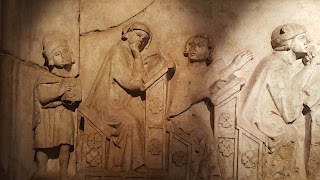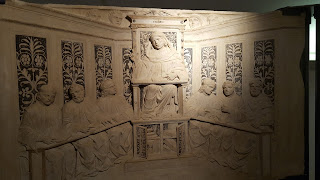As I mentioned in this post there was a local event last weekend. My photos are more silly than good, but Lord Edricus is a good photograpåher and has put up a lot of photos on his Flickr - you can see them there. There are quite a lot of photos of when I became the apprentice of Mistress Helwig.
This photo was taken with a phone camera, but it does show us together :)
söndag 30 oktober 2016
onsdag 26 oktober 2016
A 1400-1410 painting from Bologna
There's still much more to be shown from my trip to Bologna. The Pinacoteca Nazionale di Bologna has some truly amazing art from the whole of Europe. The most interesting for me was, however, the 14th and 15th paintings from Bologna and its surroundings (including Rimini). The interantionally know renaissance and mannierism pieces you can find in books and catalogues, but these are rarely reproduced, if at all, and thus I wanted to photograph all of them.
This is a ca 1,5 metre wide panel on wood by Jacopo di Paolo, dated to the period 1400-1410, showing the life of the Virgin,
This is a ca 1,5 metre wide panel on wood by Jacopo di Paolo, dated to the period 1400-1410, showing the life of the Virgin,
And yes, I am planning to make much more Italian outfits from both the 14th,the 15th and the 16th century. I've wanted to since I first went to Florence last autumn, but since baron Måns and I are focuseing on the High Middle Ages in our costuming, most of it will have to wait until we step down. Though I have plans for an early 14th century Italian outfit, I just don't have any fabric for it right now.
A green belt
Last weekend was the SCA event Festival de Caderas, which my barony arranges. It was a lovely event, where I got to give out awards, eat amazing food cooked by Lord Leonardo di Pergola and hang with friends. But for me, the most important thing by far was that I was asked by Mistress Helwig Ulfsdotter to become her apprentice. I of course accepted, and got this beautiful green belt (from Lorifactor).
My friend Mistress Lia de Thornegge also took a new apprentice, the very amazing Tece de Kaxtone, as well as renewed her master-apprentice relation with Silwa af Svaneholm.
Hopefully Lord Edricus' will have nice photos of the solemn and touching event - if so I will link to those when they are up on the Internet.
My friend Mistress Lia de Thornegge also took a new apprentice, the very amazing Tece de Kaxtone, as well as renewed her master-apprentice relation with Silwa af Svaneholm.
Hopefully Lord Edricus' will have nice photos of the solemn and touching event - if so I will link to those when they are up on the Internet.
onsdag 19 oktober 2016
Both boxes are finished
Ten days ago I wrote about a box that I made for the painted glasses that I also made for the barony of Gotvik. Then I didn't have enough plywood to make the second one, but a week ago I got on the tram and bought some more. And now they are both finished:
As you can see I also made small linen napkins to wrap around the glasses, and printed ermine in the corners.
söndag 16 oktober 2016
New headwear
I don't need any new clothes from the High Middle Ages, and I can't knit right now because of my arthritis, and, I have also run out of pergamanata, so I can't make scrolls. But I need craft projects, or I'll go crazy.
So I made some new headwear, trying a new version of the 13th century pleated fillet.
So I made some new headwear, trying a new version of the 13th century pleated fillet.
Maceijowski Bible, ca 1250
I've made several other interpretations of pleated, wavy, or decorated white fillets, trying new techniques, and one day I will make a post evaluating them all, but not today. I like how this one looks though and will wear it to an event next weekend. I also like having braids hanging down, after finding so many examples from the 13th century.
I also made me a new early 14th century hood (Mr Claus hoods my friend Anna and I call them, because quite a few are red with white lining, presumably fur).
Grosse Heidelberger Liederhandschrift, top, left corner
Mine is blue wool, lined in white self-striped linen.
My previous hoods of this type has only been rectangles sewn together, because that's how they look in the pictures, but for this one I added a gore in the back and it makes it sit better on the head.
lördag 15 oktober 2016
A pair of printed 13th century braies
Two things coincided: I found a 13th century image showing braies with a pattern on - embroidered or printed, and the baron of Gotvik turned 40. It was soem weeks ago, but now I finally got to give them to him, since hubby, my daugther Maja and I went to the fighter practice to say hello. Then we took a long walk in the park in the beautiful autumn weather, catching a few pokémon.
Patterned braies:
As soon as i saw that image I knew that I wanted to make patterned braies, so I made hand sewn linen braies with a printed pattern of ermine (from Gotvik's device) for the baron. Here modeled by my husband.
Patterned braies:
From the Trinity Apocalypse
As soon as i saw that image I knew that I wanted to make patterned braies, so I made hand sewn linen braies with a printed pattern of ermine (from Gotvik's device) for the baron. Here modeled by my husband.
The stamp which I used to make the pattern was my first attemt at carving my own stamps.
It's some kind of plastic material, I got it from Flying Tiger Copenhagen, which is a chain of knick-knack stores.
Me, printing the fabric before sewing the pieces together.
söndag 9 oktober 2016
A box for a painted glass
As you may have noticed I don't only do textile crafts. In May, for instance I painted two glasses for the baron and baroness of Gotvik (currently me and a friend) based on medieval examples. Glasses were of course usually kept in chests or cupboards, but when nice glasses were taken along on travels, they usually had boxes to protect them. These could be made for example from cuir bouilli (boiled leather), or from wood. I would really like to make shaped cases for my glasses from cuir bouilli, but I have never worked with that, so I settled for wood for these boxes. Or, to be more precise: 1,5 mm plywood. Which isn't period of course, but very strong for its thickness, and reasonably easy to get hold of.
Painted wooden boxes are of course very period and I've wanted to make some for a while based on preserved medieval examples. I've painted boxes before, but they were finished boxes that I had bought, this is the first box that I have built.
In this desire I have collected lots of images of painted medieval boxes, here are some:
Box for crossbow bolts, 15th century
Box to hold the treaty of Calais, 1360
Painted wood box, Southern France, 13th century
Here's my pinterest collection of medeival boxes.
Making the boxes
First i put the glass upside down on the plywood and drew around it. This circle was used to draw an octagon. The sides are eight straight peices of plywood. I cut the plywood with a hobby knife and sanded the pieces before glueing them together. I used contact glue to start with, because it sticks instantly (if you've let it dry for 5-10 minutes before pressing together). After they had hardened for a day I added PVA glue, which is stronger in the long run. It also filled up any small cracks where the sides weren't meeting exactly.
Standing box
Open, lying down
Painted wooden boxes are of course very period and I've wanted to make some for a while based on preserved medieval examples. I've painted boxes before, but they were finished boxes that I had bought, this is the first box that I have built.
In this desire I have collected lots of images of painted medieval boxes, here are some:
Box for crossbow bolts, 15th century
Box to hold the treaty of Calais, 1360
German box for game pieces, 14th century
German box, ca 1300
German box, first half of the 14th century
German box for game pieces, ca 1300
Painted wood box, Southern France, 13th century
Here's my pinterest collection of medeival boxes.
Making the boxes
First i put the glass upside down on the plywood and drew around it. This circle was used to draw an octagon. The sides are eight straight peices of plywood. I cut the plywood with a hobby knife and sanded the pieces before glueing them together. I used contact glue to start with, because it sticks instantly (if you've let it dry for 5-10 minutes before pressing together). After they had hardened for a day I added PVA glue, which is stronger in the long run. It also filled up any small cracks where the sides weren't meeting exactly.
I also glued a narrow strip of wood to the sides, where the hinges and clasp would be later.
I used hobby paint and some gouache paints to decorate the box with symbols of the Barony of Gotvik. Inspiration was obviously taken from the preserved boxes shown above, but in a different colour scheme.
First I had intended to line the box with blue velvet, to make it soft and a little cushioning for the glass.
However, while I could press the glass into the box it was extremly tight and tended to rub off the paint from the top of the glass, despite the paint being hardened in the oven, varnished, and then hardened again!
So, I removed the velvet, and spent a lot of time removing remnants of velvet and contact glue (it wasn't as smooth as before even after hour of this) before painting the inside of the box. The glass will be pretty secure even without the velvet, since the box is snug; and because it's a strong beer glass. When I make the next box (when I have got hold of more plywood) I will just paint if of course.
Eventually I will make boxes for my family's historical glasses too, and then I will make them big enough to add a fabric lining. But those glasses are thinner and might need it.
Anyway, here are some more photos of the box, and the glass in it.
Hinges on the back
Standing box
Open, lying down
Another standing photo.
fredag 7 oktober 2016
A 13th century aquamanile of a knight, and a kneeling nobleman
Also from Museo Civico Medievale. The knight is an aquamanile ( a fancy pitcher) and the kneeling guy is the bottom of a candlestick. They're made from bronze and bot show lots of detail in their depiction of clothes, armour and horse gear. I am especially fond of how they have depicted the patterns on the fabrics.
torsdag 6 oktober 2016
14th century students
A really cool thing with Bologna is of course that it's the world's oldest university, founded in 1008. The professors were important people locally and in th 14th century it became common to make grave monuments depicting the deceased teaching, surrounded by students. These are from the Museo Civico Medievale, which is housed in a lovely medieval palace (of course). This is the courtyard:
And now we turn to the students. They are fascinating sculptures with clothing details, but above all individual faces, showing varying interest in what the teacher has to say.
Prenumerera på:
Inlägg (Atom)




































































